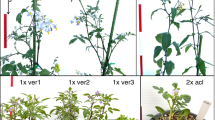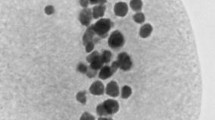Abstract
Naturally occurring/spontaneously produced polyploids with six/more genomes are rarely found in Alliums. A hexaploid form of Allium tuberosum with 2n = 48 chromosomes has been isolated for the first time amongst the open-pollinated seedlings of a hypotetraploid plant (2n = 4x = 31); latter being the seed-derived product of a normal tetraploid stock (2n = 4x = 32) growing in Jammu University Botanical Garden. Except for the guard cells and pollen grains that are of increased size, this form compared to its progenitor is dwarf, has smaller leaves and bears inflorescences with few flowers. This plant is also different from its progenitor in having nearly one-fourth (27.8 %) of its pollen mother cells (PMCs) with varying chromosome number viz. 27–64, with the remaining cells having somatic or double the somatic number of chromosomes. To assess the nature of hexaploid form, its chromosomes were studied for morphological details, putative grouping and pairing properties during reduction division. Morphological similarity in the chromosomes of the present cytotype and its progenitor, arrangement of 48 chromosomes in eight groups of six chromosomes each and presence of 21.88 % euploid cells with eight hexavalents pointed towards the autopolyploid nature of the present strain. Regarding the origin of this strain, observation made on the meiosis in the two sex mother cells of the progenitor provides some clues. In the later plant, presence of most of embryo-sac mother cells with 62 chromosomes that showed 31:31 segregations and existence of majority of the PMCs with 31 chromosomes exhibiting erratic segregations indicate that the hexaploid strain has probably originated as a result of the fusion of reduced male (n = 17) and unreduced female gamete (2n = 31).


Similar content being viewed by others
References
Adams KL, Wendel JF (2005) Polyploidy and genome evolution in plants. Curr Opin Plant Biol 8:135–141
Adams KL, Percifield R, Wendel JF (2004) Organ-specific silencing of duplicated genes in a newly synthesized cotton allotetraploid. Genetics 168:2217–2226
Albertin W, Prabant P, Catrice O, Eber F, Jenczewski E et al. (2005) Autopolyploidy in cabbage (Brassica oleracea L.) does not alter significantly the proteomes of green tissue. Proteomics 5:2131–2139
Ashraf M, Gohil RN (1994) Cytology of legumes of Kashmir Himalaya. V. Cytomixis and chromosome migration in Astragalus subuliformis D.C. Nucleus 37:119–122
Asker S (1977) Pseudogamy, hybridization and evolution in Potentilla. Hereditas 87:179–184
Blattner FR, Friesen N (2006) Relationship between Chinese Chive (Allium tuberosum) and its putative progenitor as assessed by random amplified polymorphic DNA. In: Zeder MA, Bradley DG, Emshwiller E, Smith BD (eds) Documenting domestication: new genetic and archeological paradigms. University of California Press, Berkley and Los Angeles, California
Bottley A, Xia GM, Koebner RMD (2006) Homeologous gene silencing in hexaploid wheat. Plant J 47:897–906
Choudhary R (2008) Beneficial effect of Allium sativum and Allium tuberosum on experimental hyperlipidemia and arterosclerosis. Pak J Physiol 4(2):7–9
Church SA, Spaulding EJ (2009) Gene expression in a wild autopolyploid sunflower series. J Hered 100:491–495
Comai L (2005) The advantages and disadvantages of being polyploid. Nat Rev Genet 6:836–846
Doyle JJ, Flagel LE, Paterson AH, Rapp RA, Soltis DE, Soltis PS, Wendel JF (2008) Evolutionary genetics of genome merger and doubling in plants. Annu Rev Genet 42:443–461
Fedorov AA (ed) (1969) Chromosome numbers of flowering plants. Komarov Botanical Institute, Academy of Sciences of the USSR, Leningrad, USSR
Gaeta RT, Pires JC, Iniguez-Luy F, Leon E, Osborn TC (2007) Genomic changes in resynthesized Brassica napus and their effect on gene expression and phenotype. Plant Cell 19:3403–3417
Geeta (2005) Cytogenetic studies in Allium tuberosum Rottl. ex Spreng. with emphasis on the phenomenon of apomixis. Unpublished PhD thesis, University of Jammu, Jammu, India
Gohil RN (1998) Cytology of Indian Alliums—a brief overview. In: Kachroo P (ed) Progress in cytogenetics. Bishen Singh Mahindra Pal Singh, Dehra Dun, pp 95–115
Gohil RN, Kaul R (1979) Seed progeny studies in Alliums. I. Numerical variants in the progeny of tetraploid Allium tuberosum Rottl. ex Spreng. Beitr Biol Pflanzen 54:305–309
Gohil RN, Koul AK (1971) Desynapsis in some diploid and polyploid species of Allium. Can J Genet Cytol 13:723–728
Gohil RN, Koul AK (1973a) Some adaptive genetic-evolutionary processes accompanying polyploidy in the Indian Alliums. Bot Notiser 126:426–432
Gohil RN, Koul AK (1973b) Bearing of meiotic irregularities on karyotype alterations in some polyploid taxa of genus Allium. In: Kachroo P (ed) Advancing frontiers in cytogenetics. Hindustan Publishing Corporation, New Delhi, pp 136–142
Grant V (1971) Plant speciation. Columbia University Press, New York
Grant V (1981) Plant speciation, 2nd edn. Columbia University Press, New York
Guo M, Davis D, Birchler JA (1996) Dosage effects on gene expression in a maize ploidy series. Genetics 142:1349–1355
Hamrick JL, Nason JD, Fleming TH, Nassar JM (2002) Genetic diversity in columnar cacti. In: Fleming H, Valiente-Banet A (eds) Columnar cacti and their mutualists: evolution, ecology, and conservation. University of Arizona Press, Tuscon, pp 122–133
Hanelt P (1988) Taxonomy as a tool for studying plant genetic resources. Kulturpflanze 36:169–187
Harlan JR, De Wet JMJ (1975) On O. winge prayer: the origin of polyploids. Bot Rev 41:361–390
Hegarty M, Hiscock S (2007) Polyploidy: doubling up for evolutionary success. Curr Biol 17:927–929
Hegarty MJ, Hiscock SJ (2008) Genomic clues to the evolutionary success of polyploid plants. Curr Biol 18:435–444
Jauhar PP (2010) Genetic control of chromosome behaviour: implications in evolution, crop improvement and human biology. Nucleus 53:3–12
Jones HA, Mann LK (1963) Onions and their allies. Botany, cultivation and utilization. Leonard Hill (Books) Limited, London
Khawaja HIT, Ellis JR, Sybenga J (1995) Cytogenetics of Lathyrus palustris, a natural autohexaploid. Genome 38:827–831
Kojima A, Nagato Y, Hinata K (1991) Degree of apomixis in Chinese chive estimated by esterase isozyme analysis. Jpn J Breed 41:73–83
Lavania UC (2005) Genomic and ploidy manipulation for enhanced production of pharmaceuticals. Plant Genet Resour 3:170–177
Lavania UC, Srivastava S, Lavania S, Basu S, Misra NK, Mukai Y (2012) Autopolyploidy differentially influences body size in plants, but facilitates enhanced accumulation of secondary metabolites, causing increased cytosine methylation. Plant J. doi:10.1111/j.1365-313X.2012.05006.x
Maldung A, Masuelli RW, Watson B, Reynolds SH, Davison J, Comai L (2002) Remodeling of DNA methylation and phenotypic and transcriptional changes in synthetic Arabidopsis allotetraploids. Plant Physiol 129:733–746
Mathur M, Tandon SL (1965) Cytology of an autotetraploid Allium tuberosum. Indian J Hort 22:382–384
Mau JL, Chen CP, Hsieh PC (2001) Antimicrobial effects of extracts from Chinese chive, and cinnamom and corni fructus. J Agric Food Chem 49:183–188
Ohno R (1964) Chromosomes in Allium tuberosum. J Hokkaido Gakugei Univ II B 16:17–18
Pandey A, Pandey R, Negi KS, Radhamani J (2008) Realizing value of genetic resources of Allium in India. Genet Resour Crop Evol 55:985–994
Pandita TK, Mehra PN (1981) Cytology of Alliums of Kashmir Himalayas, II. Cultivated taxa. Nucleus 43:46–56
Qu L, Hancock JF, Waylon JH (1998) Evolution in an autopolyploid group displaying predominately bivalent pairing at meiosis: genomic similarity of diploid Vaccinium darrowi and autotetraploid V. corymbosum (Ericaceae). Amer J Bot 85:698–703
Ramsey JR, Schemske DW (1998) Pathways, mechanisms, and rates of polyploid formation in flowering plants. Ann Rev Ecol Syst 29:467–501
Rutishauser A (1948) Pseudogamie und Polymorphie in der Gattung Potentilla. Arch Julius Klaus Stiftung 23:267–424
Salmon A, Ainouche ML, Wendel JF (2005) Genetic and epigenetic consequences of recent hybridisation and polyploidy in Spartina (Poaceae). Mol Ecol 14:1163–1175
Sapre AB, Naik AS (1990) Formation of aneuploid gametes through non-disjunction during pre-meiotic mitoses in Coix gigantea. Cytologia 55:71–77
Sen S (1974) Floral biology, meiosis, pollen cytology and cause of seed setting in Allium tuberosum Rottl. Caryologia 27:7–16
Sharma G, Gohil RN (2002) Chromosomal chimeras in the male track of Allium tuberosum Rottl. ex Spreng. Caryologia 57:158–162
Sharma G, Gohil RN (2008) Intrapopulation karyotypic variability in Allium roylei Stearn—a threatened species. Bot J Linn Soc 158:242–248
Soltis DE (2007) Saxifragaceae: a taxonomic treatment. In: Kulbitzki K (ed) The families and genera of vascular plants, vol 9. Springer, New York
Soltis DE, Soltis PS, Schemske DW, Hancock JF, Thompson JN, Husb BC, Judd WS (2007) Autopolyploidy in angiosperms: have we grossly underestimated the number of species? Taxon 56:13–30
Stearn WT (1946) Nomenclature and synonymy of Allium odorum and A. tuberosum. Reprinted from Herbertia (1944) 11:226–245
Stebbins GL (1950) Variation and evolution in plants. Columbia University Press, New York
Stebbins GL (1971) Chromosomal evolution in higher plants. Edward Arnold, London
Stupar RM, Bhaskar PB, Yandell BS, Rensink WA, Hart AL, Ouyang S, Veilleux RE, Busse JS, Erhardt RJ, Buell CR, Jiang J (2007) Phenotypic and transcriptomic changes associated with potato autopolyploidization. Genetics 176:2055–2067
Talukder K, Sen S (2000) Chromosome characteristics in some Allium species and assessment of their interrelationship. Nucleus 43:46–57
Wang R, Gao J, Liang GH (1999) Identification of primary trisomics and other aneuploids in foxtail millet. Plant Breeding 118:59–62
Wittkop PJ, Haerum BK, Clark AG (2004) Evolutionary changes in cis and trans gene regulation. Nature 430:85–88
Yang L, Xu JM, Zhang XL, Wan HO (1998) Karyotypical studies of six species of the genus Allium. Acta Phytotaxonomica Sinica 36:36–46
Acknowledgments
The first author is grateful to the Head, Department of Botany, University of Jammu, Jammu for providing the necessary facilities and to DST, Govt. of India, New Delhi for providing financial assistance.
Author information
Authors and Affiliations
Corresponding author
Rights and permissions
About this article
Cite this article
Sharma, G., Gohil, R.N. Origin and cytology of a novel cytotype of Allium tuberosum Rottl. ex Spreng. (2n = 48). Genet Resour Crop Evol 60, 503–511 (2013). https://doi.org/10.1007/s10722-012-9852-4
Received:
Accepted:
Published:
Issue Date:
DOI: https://doi.org/10.1007/s10722-012-9852-4




